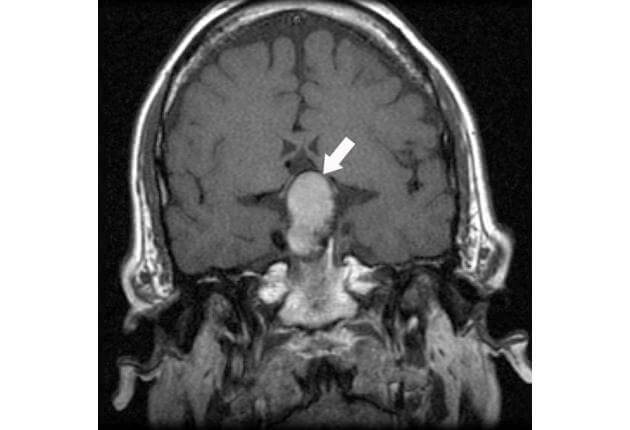Pituitary Tumor (adenoma)
Pituitary tumors are benign growths of cells in the pituitary gland, the gland that controls most of the hormone function in the body (e.g. thyroid, adrenal, sexual organs). Small tumors of the pituitary are very common and usually without symptoms, unless the tumor produces a hormone. However if the tumor enlarges, it can cause hormonal deficiencies by pressing on the normal pituitary cells. If it grows even larger (> 1 centimeter), it can cause visual loss or double vision.
What are the Symptoms of Pituitary Tumors?
When the tumor enlarges it often causes headache. On rare occasion there is a sudden, severe headache from bleeding into the tumor. This is called pituitary apoplexy and is a medical emergency.
The hormonal symptoms depend on whether the tumor is producing a hormone. The most common hormone produces is prolactin. In women, this can cause loss of menstrual periods (amenorrhea) and fluid discharge from the breasts (galactorrhea). In men, this can cause loss of sexual desire and impotence Less commonly, tumors may produce growth hormone causing gigantism in young patients or enlargement of hands, feet, and facial features (acromegaly) in older patients
Many patients are not diagnosed until the tumor is large enough to cause visual symptoms. The most common of these symptoms is due to compression of the optic nerves or optic chiasm, which is located directly above the pituitary gland. Patients with involvement of one optic nerve may notice dim, dark, or blurred vision in one eye. Occasionally this may be noted when one happens to cover one eye and notes that they can't see out of the opposite eye. If the optic chiasm is affected, vision will be lost off to the periphery in both eyes (the right side of space in the right eye and the left side of space in the left eye).
The other main symptom may occur if the tumor grows laterally instead of superiorly. It may then compress one of the three nerves which control eye movement. This can cause double vision, eyelid drooping or an enlarged pupil.
How are pituitary tumors diagnosed?
The first step is the clinical impression from the history and findings on examination.
If there is a clinical suspicion, then an MRI is performed. If for some reason an MRI can not be performed (eg. Pacemaker), then a CAT scan is performed. Below is a large pituitary tumor in the patient with the above visual fields.
Additionally, blood work to measure pituitary hormones are performed if a tumor is found. Not all growths in this region are pituitary tumors. Other possibilities in the same region include include meningiomas, craniopharyngiomas, and aneurysms.
How are pituitary tumors treated?
Small tumors may not need to be treated. However follow up with periodic MRI and tests of visual function are important to be sure that vision is preserved.
When the patient is symptomatic, some form of treatment is usually indicated. The most common approach is surgical with a trans-sphenoidal hypophysectomy performed through the nose.
If the tumor is too large to be completely removed, additional treatment may be required. This may include repeat surgery or radiation therapy.
Some tumors (mainly those that produce prolactin) may be responsive to medical therapy. However, the medication must be continued indefinitely, or the tumor will continue to grow.
It is very important to follow vision, visual fields, and imaging studies (MRI scan) to make sure that there is no re-growth of the tumor, even years after treatment.


